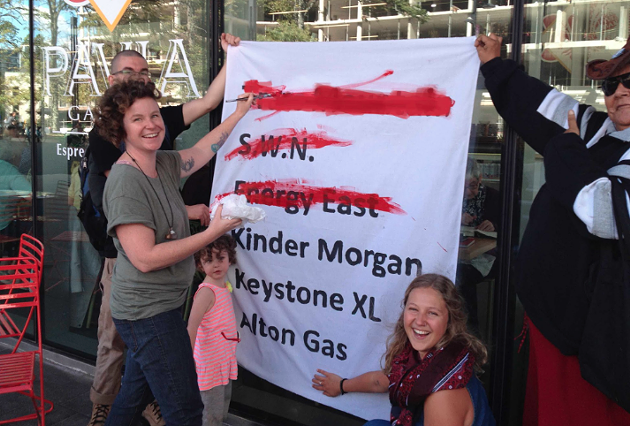
VIA TWITTER
News of the pipeline's passing was celebrated in the streets.
Energy East, the gargantuan, $16-billion pipeline project that would have transported over one million barrels of oil a day from Alberta to New Brunswick, has died.
It was four-years-old.
Parent company TransCanada announced the death of its 4,500-kilometre pipeline baby on Thursday morning. Chief executive officer Russ Girling offered his thanks to the businesses,
“Most of all, we thank Canadians across the country who contributed towards the development of these initiatives,” Girling states.
Energy East's sibling, the Eastern Mainline natural gas project, was killed in the same news release.
Condolences flowed in from across the country, including New Brunswick premier Brian Gallant, Alberta premier Rachel Notley and federal Conservative House leader Lisa Raitt, who called the decision “disastrous.”
Cause of death is not yet known. Girling cites “changed circumstances” in his news release, while federal energy minister Jim Carr told reporters it was a business decision based on oil prices, having little to do with government regulation.
In recent months Energy East had been battling a regulatory application by the National Energy Board. Its health took a turn for the worse when the NEB ruled that review would include climate change impacts and oil tanker traffic.
A report by environmental think-tank the Pembina Institute found the pipeline project had the capacity to generate 32 million tonnes of new greenhouse gases each year.
Energy East—which potentially would have put the drinking water for over five million Canadians at risk—was also considered controversial by many of the towns, municipalities and First Nations running along its proposed route.
News of its death was met with celebration by some of those same critics.
“Today is a great day for the climate and the hundreds of thousands of Canadians who stood up to Energy East and its risks to our land, water and communities,” Andrea Harden-Donahue with the Council of Canadians said in a press release.
“Both the Northern Gateway fight and this Energy East one show that when First Nations stand together, supported by non-Indigenous allies, we win,” writes Grand Chief Serge Simon of the Mohawk Council of Kanesatake, on behalf of the 150 First Nations and tribes who made up the Treaty Alliance Against Tar Sands Expansion.
“This is an enormous win,” said Stephen Thomas, energy campaign coordinator with the Ecology Action Centre. “For the past five years a broad movement of people in frontline communities and across Canada have been working to stop this pipeline. These communities took on the largest pipeline ever proposed in North America, and they won.”
Funeral arrangements are expected to cost TransCanada $1 billion next quarter. In lieu of donations, maybe just idle your car for a couple hours.
Energy East is survived by its sibling, the Keystone XL pipeline, along with cousins Trans Mountain Expansion (Kinder Morgan) and Line 3 Replacement (Enbridge).
